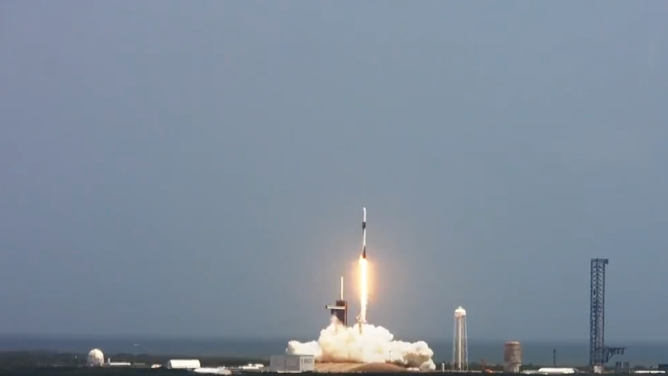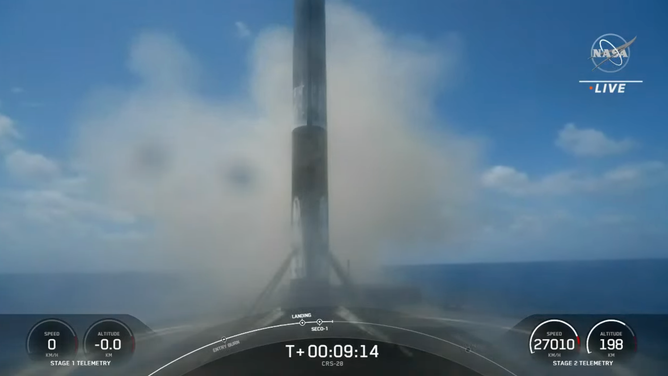SpaceX launches supplies to International Space Station after weather delays
Twice delayed due to weather conditions, SpaceX launched the Dragon spacecraft at 11:47 a.m. EDT from Kennedy Space Center in Florida carrying new science, supplies and two roll-out solar arrays to the International Space Station.

A SpaceX Falcon 9 rocket launches supplies to the International Space Station from Kennedy Space Center, Fla., on June 5, 2023.
(NASA)
KENNEDY SPACE CENTER, Fla. – A SpaceX Dragon spacecraft launched from Florida on Monday, sending more than 7,000 pounds of fresh groceries and supplies to the International Space Station.
After two previously scheduled launch attempts were called off over the weekend, SpaceX’s Falcon 9 rocket successfully launched the Cargo Dragon at 11:47 a.m. EDT on Monday from Kennedy Space Center launchpad 39A. The liftoff marked the company's 28th cargo resupply mission for NASA.
Both attempts on Saturday and Sunday were scrubbed due to rain and storms from former Tropical Storm Arlene – the first named storm of the 2022 Atlantic hurricane season.
On Monday, the sky above historic launchpad 39A was mostly clear, and forecasters with the 45th Weather Squadron predicted an 80% chance of favorable weather for liftoff.

A SpaceX Falcon 9 booster after landing on a droneship in the Atlantic Ocean. The landing marked the 198th for SpaceX.
About eight minutes after blasting off, the Falcon 9 booster returned to Earth, landing on a droneship in the Atlantic Ocean. The booster recovery marked the fifth for the rocket and the 198th landing overall for SpaceX's Falcon 9.
Dragon bringing groceries, science and hardware to astronauts

Inside the Space Station Processing Facility high bay at NASA's Kennedy Space Center in Florida, technicians assist as a crane is used to lower a set of International Space Station Roll Out Solar Arrays (iROSA) onto a platform on March 23, 2023.
(NASA)
The SpaceX spacecraft will deliver supplies to the astronauts living and working in space, including food, new science experiments and essential equipment.
A pair of International Space Station rollout solar arrays, or iROSAs, made by Redwire Space were among the cargo launched to the International Space Station.
The two arrays are the third set launched by SpaceX over the past two years and will complete the ongoing upgrade to the station's power grid. The solar arrays will help power the International Space Station through 2030.
The solar arrays ride up to the International Space Station in the trunk of the Dragon spacecraft and then unfurl in space like rolled-out carpets.
NASA astronauts Stephen Bowen and Woody Huburg will spacewalk on Friday, June 9, to install one of the two new solar arrays.
In December, NASA astronauts Frank Rubio and Josh Cassada installed the second pair of arrays. The final iROSA will be installed during a spacewalk later this year.
The Dragon spacecraft will spend about a month docked at the space station before returning to Earth.